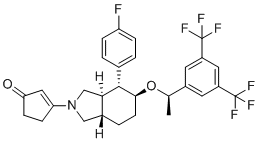
Serlopitant
CAS No. 860642-69-9
Serlopitant( VPD-737 | MK-0594 )
Catalog No. M16236 CAS No. 860642-69-9
Serlopitant (VPD-737, MK-0594) is a potent, selective substance P/neurokinin 1 (NK1) receptor for treating chronic pruritus.
Purity : >98% (HPLC)
 COA
COA
 Datasheet
Datasheet
 HNMR
HNMR
 HPLC
HPLC
 MSDS
MSDS
 Handing Instructions
Handing Instructions
| Size | Price / USD | Stock | Quantity |
| 5MG | 1229 | In Stock |


|
| 50MG | 2507 | In Stock |


|
| 100MG | 3168 | In Stock |


|
| 200MG | Get Quote | In Stock |


|
| 500MG | Get Quote | In Stock |


|
| 1G | Get Quote | In Stock |


|
Biological Information
-
Product NameSerlopitant
-
NoteResearch use only, not for human use.
-
Brief DescriptionSerlopitant (VPD-737, MK-0594) is a potent, selective substance P/neurokinin 1 (NK1) receptor for treating chronic pruritus.
-
DescriptionSerlopitant (VPD-737, MK-0594) is a potent, selective substance P/neurokinin 1 (NK1) receptor for treating chronic pruritus.Alcoholism Discontinued.
-
In Vitro——
-
In Vivo——
-
SynonymsVPD-737 | MK-0594
-
PathwayGPCR/G Protein
-
TargetNeurokinin Receptor
-
RecptorNeurokinin Receptor
-
Research AreaNeurological Disease
-
IndicationAlcoholism
Chemical Information
-
CAS Number860642-69-9
-
Formula Weight555.537
-
Molecular FormulaC29H28F7NO2
-
Purity>98% (HPLC)
-
Solubility——
-
SMILESO=C1C=C(N2C[C@@]3([H])CC[C@H](O[C@@H](C4=CC(C(F)(F)F)=CC(C(F)(F)F)=C4)C)[C@@H](C5=CC=C(F)C=C5)[C@]3([H])C2)CC1
-
Chemical Name3-((3aR,4R,5S,7aS)-5-((1R)-1-(3,5-bis(Trifluoromethyl)phenyl)ethoxy)-4-(4 fluorophenyl)octahydro-2H-isoindol-2-yl)cyclopent-2-en-1-one
Shipping & Storage Information
-
Storage(-20℃)
-
ShippingWith Ice Pack
-
Stability≥ 2 years
Reference
1. Yosipovitch G, et al. J Am Acad Dermatol. 2018 May;78(5):882-891.e10.
molnova catalog



related products
-
Befetupitant
Befetupitant (Ro67-5930) is a potent and selective tachykinin 1 receptor (NK1R) antagonist for the study of corneal neovascularization.
-
MLE-4901
A potent, selective, orally active neurokinin 3 (NK3R) antagonist for the treatment of schizophrenia.
-
Serlopitant
Serlopitant (VPD-737, MK-0594) is a potent, selective substance P/neurokinin 1 (NK1) receptor for treating chronic pruritus.



 Cart
Cart
 sales@molnova.com
sales@molnova.com


